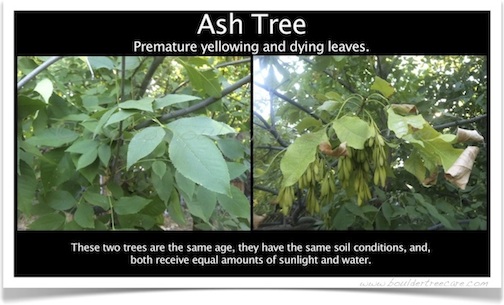Important Update: About Emerald Ash Borer (EAB) in Boulder
Lately, several of our clients have been wondering why the trees on their property look like they are dying (trees that recently seem perfectly healthy). Here is a photo that helps to demonstrate the different changes trees may go through during their lifetime.
These ash trees are a great example of the different growth cycles trees experience. The tree (left) seems perfectly healthy, green and vital while the tree next to it has premature, yellowing leaves that are dying during the summer this year.
These two trees (click on picture to enlarge) live right next to one another. They are the same age, have the same soil conditions, and, both receive equal amounts of sunlight and water. Last year they both looked almost identical and this year they look completely different from one another.
Why?
Part of the reason they look so different is that the one on the right has been producing seeds all year. It grew just as many leaves as the one to the left and it also grew, literally, thousands and thousands of seeds. For such a small, young tree that seems like a lot of additional work. The amount of *NPK, water and sunlight to create that much plant material must be quite a bit more than the tree that produced only leaves. I imagine the size of the root systems are close to the same, given the similar size, age and growing conditions. But… You never really know unless you have a chance to see all the roots (good luck with that).
A question I have been asked more than once is:
Do these trees go to seed when they “know” they are going to die or is the process of making seeds just making it look as though they are dying.
My experience has shown me, more often than not, ash trees recover the following year just fine. Although, recently a woman said her tree has gone to seed two years in a row (we’ll just have to wait to understand what happens to the overall health of the tree when this occurs).
In this case, (ash tree with premature yellowing leaves that are dying) I don’t think that the tree on the right will die any time soon. It is a young tree that lives in a great location and will probably thrive for many years. These trees get enough water with a nice bed of natural mulch and decent drainage, are in a good sunny spot, have no other trees around to compete with, and, these ash trees are strong, little trees.
Note: Different circumstances can cause symptoms that look similar.
- Too much or not enough water can turn leaves yellow.
- Not enough nitrogen, especially when a plant is in a vigorous growth cycle, can cause premature yellowing (in the springtime when it is producing all of it’s leaves or when a tree is having a bumper crop year and has begun to create an unusual amount of fruit).
- The wrong pH can block the uptake of available nutrients and may create the appearance of a nutrient deficiency.
- An imbalance of fungus, bacteria or other pathogens that feed off a tree’s vitality.
- Other trees and plants that are competing for sunlight, nutrients or are producing a phytotoxic (an organic, poisonous substance derived from plants) environment which is killing other plants to help establish themselves.
While any of these might cause premature yellowing leaves that are dying and falling off the tree, most of these symptoms require different treatments. If you treat a tree that has a pH that is preventing it from being able to absorb nutrients with fertilizer (because appears to be nutrient deficient) the tree may decline more rapidly.
We’ll see what is to come of them both, next year…
After months of observation and investigation, we finally discovered what has been killing the leaves on these trees…
Changes in Trees
Changes in Trees – Test Results
*NPK – Nitrogen, Phosphorous, and Potash (Potassium)
Boulder Tree Care writes articles about daily experiences while providing tree care in Boulder, Colorado.
Articles from our tree care blog.
